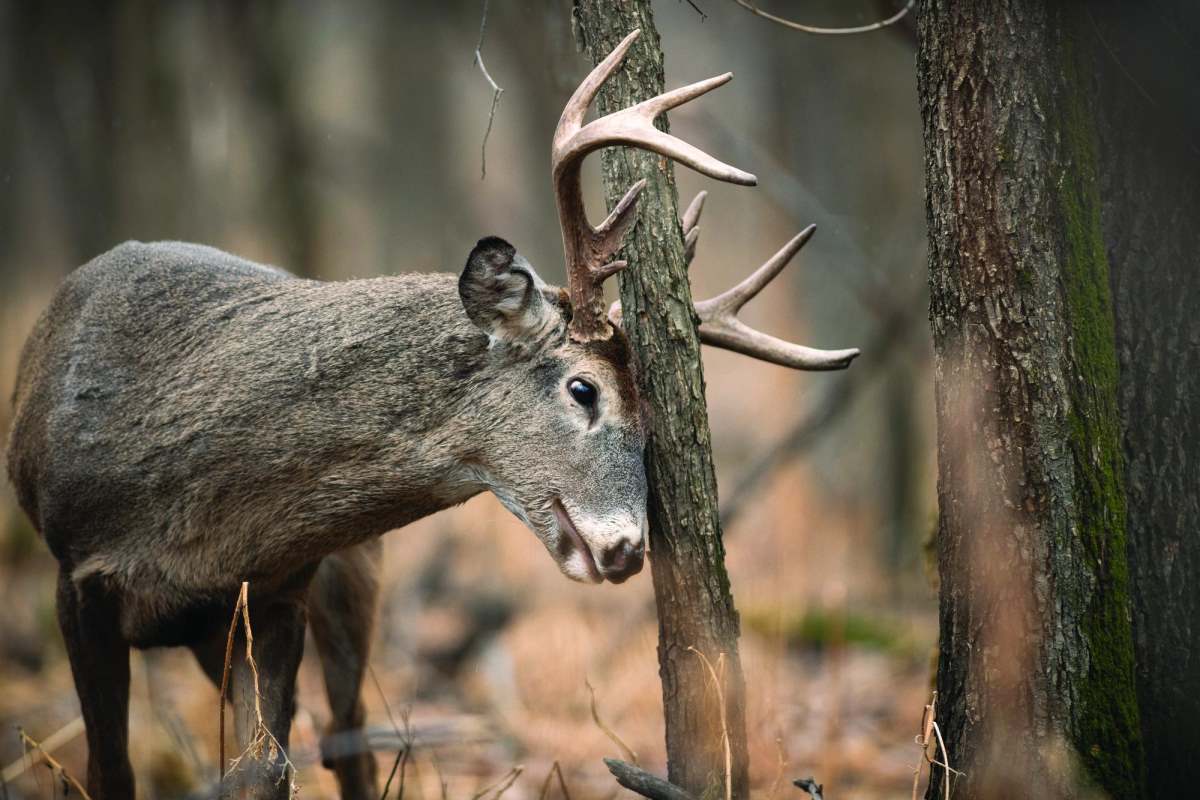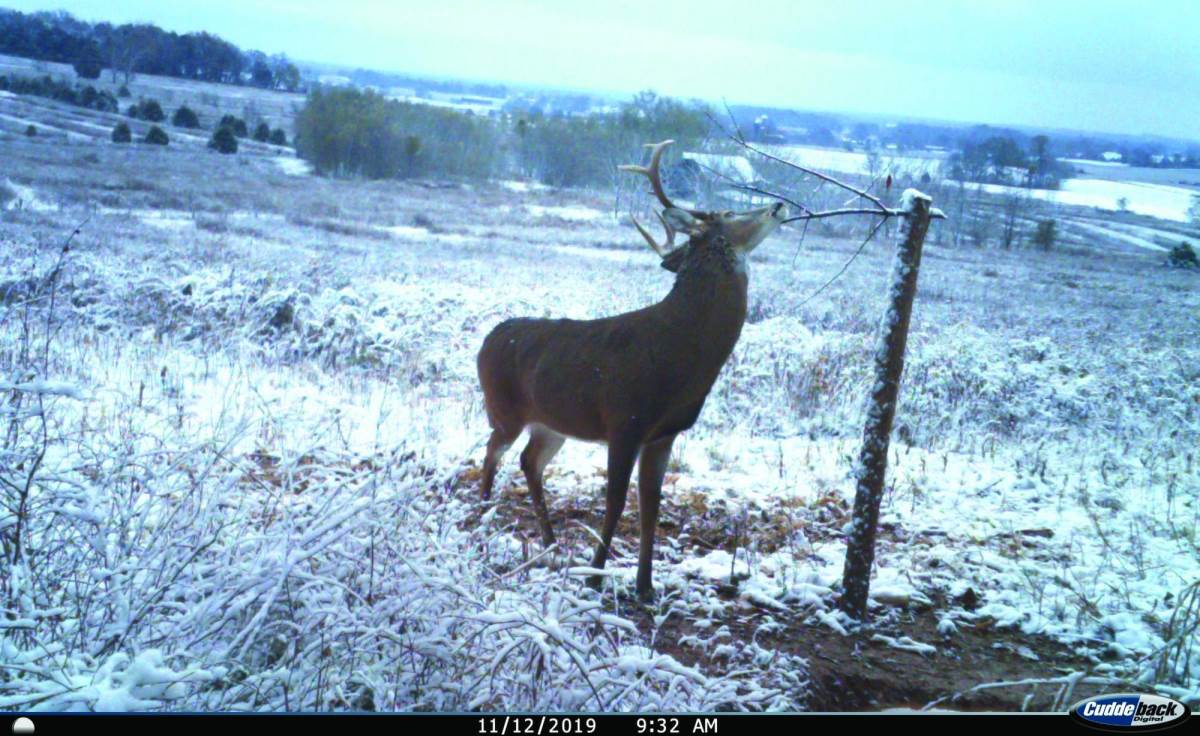
If you hunt in a place where supplemental feeding and baiting are illegal, you’ll need an alternative method to lure in bucks. Whether it’s on a rub line, mock scrape or a food plot, there are plenty of ways to legally attract bucks without bait. Photo by Matt Hansen
Baiting bans are hitting throughout the nation. So, millions of hunters no longer have the option of baiting, and they’re left with alternative methods for luring bucks in without bait. For those who can’t or choose not to use conventional attractants, the following are potential ways to lure bucks in for trail camera pictures, shot opportunities or both. Check out these tips to use a buck’s senses against it, whether it be sight, sound, smell or taste.
Calling
One of the oldest tricks in the books, whitetails commonly fall for calling efforts. Well-executed vocalizations are certainly great for luring a buck within range. Using a deer call isn’t as easy as some believe it to be, though. While easier than learning to call turkeys or elk, it’s still a learned skill that takes time. Understanding what various vocalizations mean, how to reproduce them, and when to implement each sound are just part of the equation. You also must observe the deer you’re calling to, read its body language and reactions, and adjust your calling tactics accordingly.
The same is true for rattling. There are certainly right and wrong ways to do this. For example, the right rhythm is no rhythm at all. One of the biggest mistakes hunters make is repeating a cadence, which isn’t natural in buck fights. It’s sporadic and varying in duration, sound and volume. Still, when used correctly, it can lure a buck just fine.
Decoying
Another popular method for pulling a deer into range is decoying. This tactic is especially helpful for bowhunters. Placing a decoy in the right position is the ticket, though. In most cases, stake it into the ground quartering slightly toward you. It’s common for a dominant buck to approach it head-on, effectively offering you an ethical, quartering-away shot opportunity.
Some mistakes to avoid when using decoys include: deploying decoys at the wrong time of year; handling them without gloves; positioning them downwind of your setup or in thicker areas; staking decoys more than 15 yards from your tree stand or blind; and using decoys in feed fields during the afternoon.
Fertilized Ground
Most hunters don’t realize it, but deer know what their bodies are lacking, and they have cravings just like humans do. Furthermore, they recognize which plants offer more nutrition and are more palatable. They can even tell the difference in taste and overall quality between plants of the same species.
Because of this, you can make deer feed exactly where you want them to, no bait necessary. Simply fertilize plants and trees in areas deer already frequent, and they’ll likely target these over nearby options. You see, fertilizer enriches the nutritional value and taste of a plant, tree or its fruit. Deer can somehow sense this, and target food sources accordingly. Use this to your advantage by fertilizing natural vegetation in areas that benefit your hunting efforts.
Food Plots
Forage is excellent for attracting deer. Plus, food plots are legal in virtually every private land scenario. Check your hunting regulations to be sure. There’s no reason to risk it. For those who choose to use food plots to lure deer, it’s important to plant these in a strategical manner. Larger feed plots can certainly attract and hold deer, but filling a tag isn’t possible if they don’t use it during daylight or make it within range. To boost daylight use, push food plots closer to known bedding areas and create quality screening cover that prevents anything from seeing into or out of the plot.
Establishing entry and exit routes that don’t spook deer and using low-impact hunting strategies are beneficial, too. To increase shot opportunities and improve odds of a deer making it within range, consider planting food plots in shapes that force deer through a pinch point, such as a T, U, J, L, V, hourglass or turkey foot. Then, position a tree stand or blind in the pinch.
Funnels and Pinch Points
Benches, saddles, creek crossings, ditch crossings, fence gaps, trail intersections, fingers of trees, thin strips of cover and inside corners can all pinch or funnel deer movement. These land features certainly lure deer into or through specific locations. Naturally, identifying these places and finding ambush locations within them can prove effective. Hunting the downwind sides of these should produce a good number of sightings.

Horizontal Rubbing Posts
Horizontal rubbing posts are increasing in popularity. While it’s certainly a learned behavior, in my experience, deer seem to gravitate to these. First, cut a cedar or pine tree that’s 4-6 inches in diameter. Next, find two straight trees within a few feet of each other. Then, secure the horizontal post to each one about three feet from the ground using sturdy rope or wire.
Secure it tightly so that the rubbing post moves only slightly when heavy pressure is applied. Also, draw up any slack in the rope or wire so antlers don’t get caught in it. For those who choose to implement the tactic, if legal where you hunt, consider jump-starting the post with some natural or synthetic deer scent.
Create a Jungle
Deer love extremely thick areas; there’s no better place for mature bucks than heavy cover. If you create some thick vegetation, deer will come. Aside from offering quality food sources, and limiting hunting pressure, creating a jungle of cover is the best way to attract mature bucks to your property. Achieve this by safely implementing discing, controlled burns and timber thinning.
Mast Trees and Plants
Trees and plants that produce a berry, fruit, nut or seed can be whitetail magnets. Hard mast trees such as beech, chestnuts, hickory, honey locusts and oaks, provide great food for deer. Soft mast trees such as apples, crabapples, pear, persimmon and plums also provide great nutrition. Plants to focus on include blackberry, blueberries, grapes, mulberry, raspberries and strawberries. Either find these species naturally growing on your property or plant them to serve as excellent deer lures.
Mineral Sites
In some states, minerals are considered bait. In others, these aren’t. If the fine print allows, consider using trace mineral and white salt to lure deer. These generally only work in the spring, summer and late winter. But certainly, consider it where legal. A good mineral site can attract deer from great distances.
Mineral Stumps
Like mineral sites, mineral stumps were recently made famous by the Mississippi State University Deer Lab. The sprouts that emerge are highly nutritious due to increased mineral infusions. And, since the stumps elevate what deer are feeding on, there’s a decreased risk of consuming infected materials otherwise present in the soil. This is a safer way for deer to consume the minerals they need to remain healthy.
Mock Scrapes
First introduced long ago, mock scrapes continue to be excellent for luring in deer. Creating fake scrapes in strategic locations is a very useful tactic, especially when crafted correctly and mindfully. Placing these in areas deer already frequent, and leaving them free of human scent, can go a long way. When building these, it helps to use sappy branches, vines or even synthetic ropes as the licking branch. Where legal, jumpstarting mock scrapes with natural or synthetic deer scent can encourage deer to use them sooner. If natural or synthetic scents aren’t permitted, some hunters have found success peeing in mock scrapes themselves. Deer are curious animals and gravitate to the smell.
If there are no suitable locations to place a mock scrape, consider planting a scrape tree. Plant a real tree with a branch (or branches) at the appropriate height. Or bury a post with roughly 2-3 feet of it underground and 5-6 feet above ground. Then, drill a hole through the top end and insert a licking branch. Secure the branch with a screw, and then clear out the ground underneath the limb.
Natural Scrapes
If natural scrapes already exist, these are even better than mock scrapes. Deer are already using these, and there’s no start time or adoption period. It’s merely a plug and play situation with immediate results. Interestingly, deer use scrapes year-round, even during spring and summer. This makes these an exceptional option for luring deer for 12 months out of the year.
Scents
Where hunting laws permit it, natural and synthetic scents are great standalone options, too. From hanging wicks to scent drags, these are curiosity boosters for deer, effectively luring them into a specific location. Where natural urines and scents aren’t allowed, consider synthetic urines and scents. If that isn’t an option, and other aerosol scents are (think food-based smells), consider these instead.

Water Holes
Last on this list, and perhaps the most potent, are small watering holes. Big, mature bucks can drink up to 3-5 quarts per day. Oftentimes, deer bed down relatively close to water, even if it’s a small, stagnant source. Placing these in strategic locations can be an excellent way to lure deer into specific areas during daylight hours.
In Conclusion
As baiting laws continue to change throughout much of the country, hunters will look to alternate options for attracting whitetails. Where hunting laws allow, consider the options above, or create a new concept that works for you. Luring bucks in without bait is very possible, and the methods in this article can help you do it!







